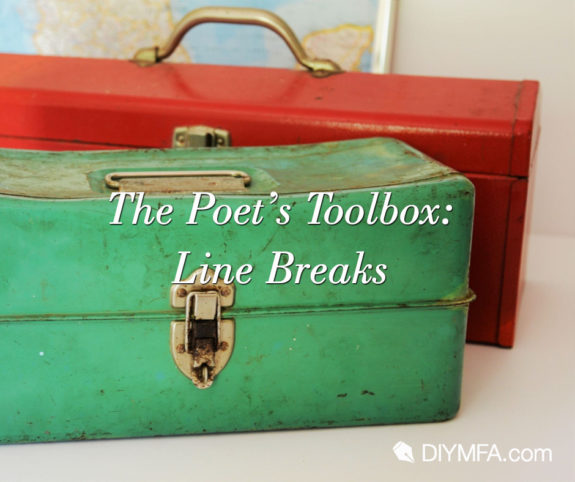Hi, writers! I am so excited to debut my new column focusing on the craft of poetry. Let’s dive right in! Line breaks were one of the biggest challenges I faced when I first started writing poetry—knowing when to break a line, when to use short lines vs. long lines, and, perhaps most importantly, the difference between poetry and…well, a very, very short story that just so happens to be broken into lines.
What are Line Breaks?
To better understand how line breaks function, and what they can do for your poetry, I think it’s helpful to first consider Kim Adonizzio and Dorianne Laux’s definition in The Poet’s Companion: “…think of line breaks as effects; learn the different effects you can achieve, and then decide which you want.”
Unless you’re writing in more traditional forms—such as the haiku or villanelle—that have syllabic restrictions, a set rhyme scheme, or other defined pattern, line breaks are generally not governed by hard and fast rules. Instead, it’s up to you as the poet to decide when and how to break a line.
Rather than thinking of line breaks as purely random, it might be helpful to think of them as ways to enhance your poem. An enjambed line, for example, can help create a feeling of continuous movement in your poem. Irregular line breaks can be used to create a sense of surprise or tension within the poem. Again, as Adonizzio and Laux state in The Poet’s Companion, line breaks should be viewed as effects, and when you are familiar with the different effects line breaks can have on your poetry, you can use them to your advantage.
Today I want to specifically focus on line length, enjambment, and end stops. I’ll talk about what each of these techniques can do for your poetry, as well as some of the writing exercises I use to experiment with line breaks in my own work.
Line Length
If you’re writing a poem using a more traditional form, particularly one with syllabic restrictions, line length is oftentimes determined for you. The haiku is one example of this, as the line length is determined by syllables—the first line has five syllables, the second line has seven syllables, and the final line has five syllables. The sestina is another example of a form that has a set length as it consists of thirty-nine lines—all typically of the same length. However, if you’re not working within one of these forms, line length is completely up to you! Your poem can be written using short lines, long lines, medium lines, or even a mix of all three.
Although every reader and writer of poetry is different, one way to look at the effect line length has on a poem is in the ways it either slows or speeds up the reading of the poem. Typically, longer lines are read at a much faster pace than shorter lines. Short lines tend to slow down a reader’s eye, especially if you’re also spacing these lines farther apart on the page.
Long lines can also create the effect of breathlessness or urgency in a poem, especially if you also omit punctuation. Short lines can create more tension in a poem and, depending on where you place them on the page, it can also create a feeling of disjointedness. You can also choose to vary your line lengths, placing emphasis on the way they physically appear on the page.
Line Enjambment
An enjambment is a phrase or line that carries over into the next line, like what appears in Louise Glück’s poem “Prism”:
Who can say what the world is? The world
is in flux, therefore
unreadable, the winds shifting,
the great plates invisibly shifting and changing—
In the above example, the first line ends in the middle of the phrase “The world,” and carries over into the second line. By ending the first line on “The world,” the thought is incomplete, creating tension in the stanza. The final word of the line, “world,” is not followed by any kind of punctuation—a period or comma, for example—which places less emphasis on the final word and, instead, creates a sense of forward momentum, drawing the reader’s eye more quickly to the second line.
Enjambed lines are an excellent tool to use if you want to amplify tension in your poem, and, much like using longer lines to create a sense of breathlessness or urgency in a poem, enjambment can be used in much the same way.
End-Stopped Lines
End-stopped lines are lines that end where a pause might occur, such as at the end of a sentence or thought. Most of the time, end-stopped lines are marked by periods, commas, semicolons, or hyphens. Natalie Diaz uses end-stopped lines in her poem “From the Desire Field”:
I don’t call it sleep anymore.
I’ll risk losing something new instead—
like you lost your rosen moon, shook it loose.
The above three lines are all end-stopped lines—they are complete thoughts or phrases ending in periods or, in the case of the second line, a hyphen. Notice also how Diaz uses stanza breaks. Instead of closing the space between the second and third line, Diaz utilizes a stanza break; in the full poem, the third line stands on its own as a one line stanza. Not only does this draw the reader’s eye to the single line, but the space also disrupts the momentum of the sentence, causing the reader to pause longer between “instead—” and “like.”
End-stopped lines are good to use if you’re looking to create a sense of closure, or completeness, in your poetry, although that’s certainly not all they’re good for! End-stopped lines can also be used to slow down the rhythm of a poem.
Writing Exercises
Now that you have a better understanding of the different effects line breaks can have on your poetry, try practicing these different techniques in your own work. Here are a couple exercises to get you started:
1. Take a short section of prose—something that you’ve written yourself or from a writer that you admire—and break it into both enjambed and end-stopped lines. Pay close attention to the effect your line breaks have on the reading of the prose—both on the page and out loud. Note also how the meaning of the prose might change slightly depending on where you decide to break the lines.
2. Take a poem that you’ve already written—or one that you admire—and try rearranging the lines so that they’re all enjambed, except for the final line. What effect does this have on the poem?
3. Similar to the previous prompt, take a poem and rearrange the lines so that most, if not all of them, are end-stopped. What effect does this create?

Manuela Williams lives and writes in Nevada. She is the author of two poetry chapbooks and one paranormal fiction novella. When she’s not writing, Manuela loves reading romance novels, drinking *all* the coffee, and playing video games.







